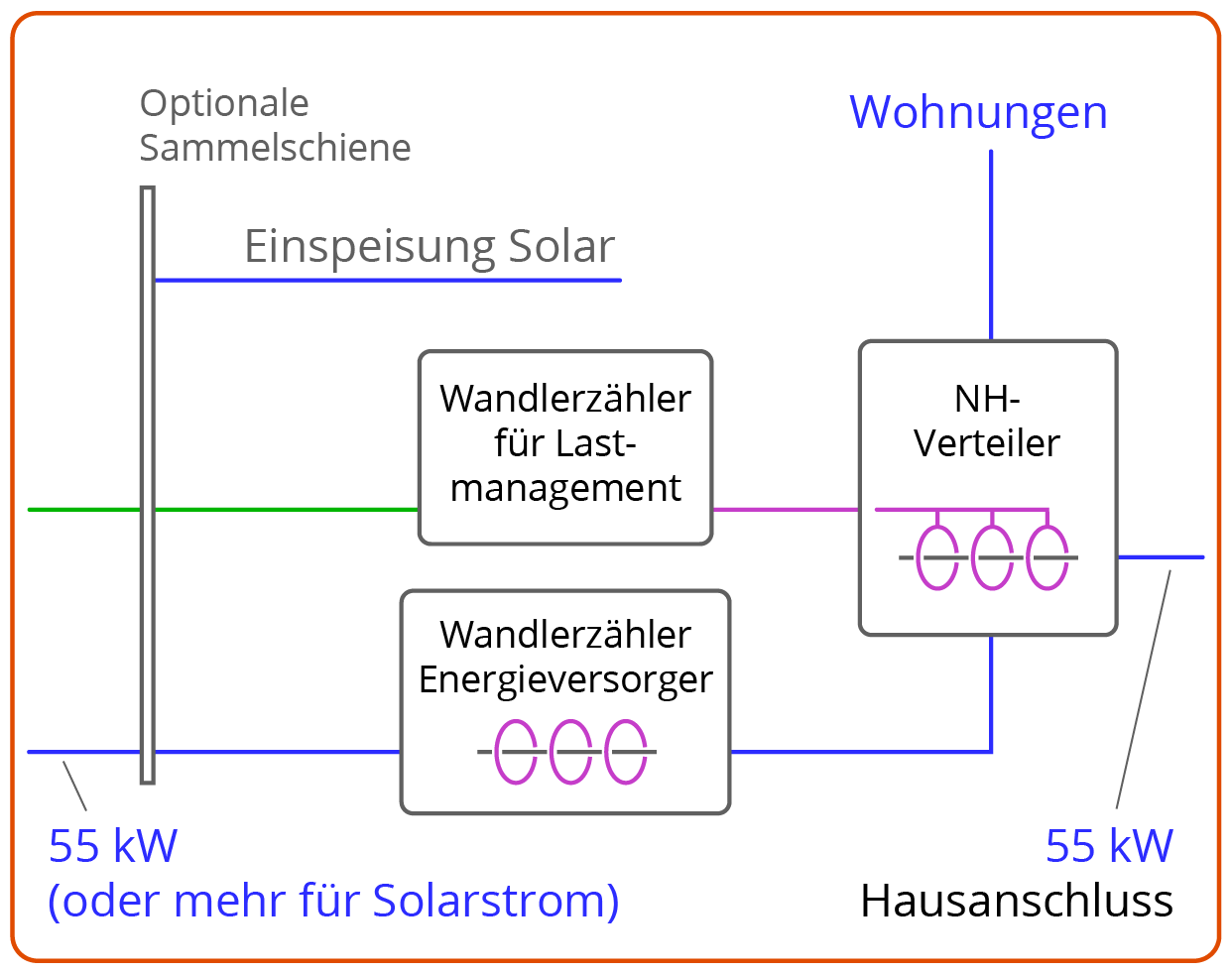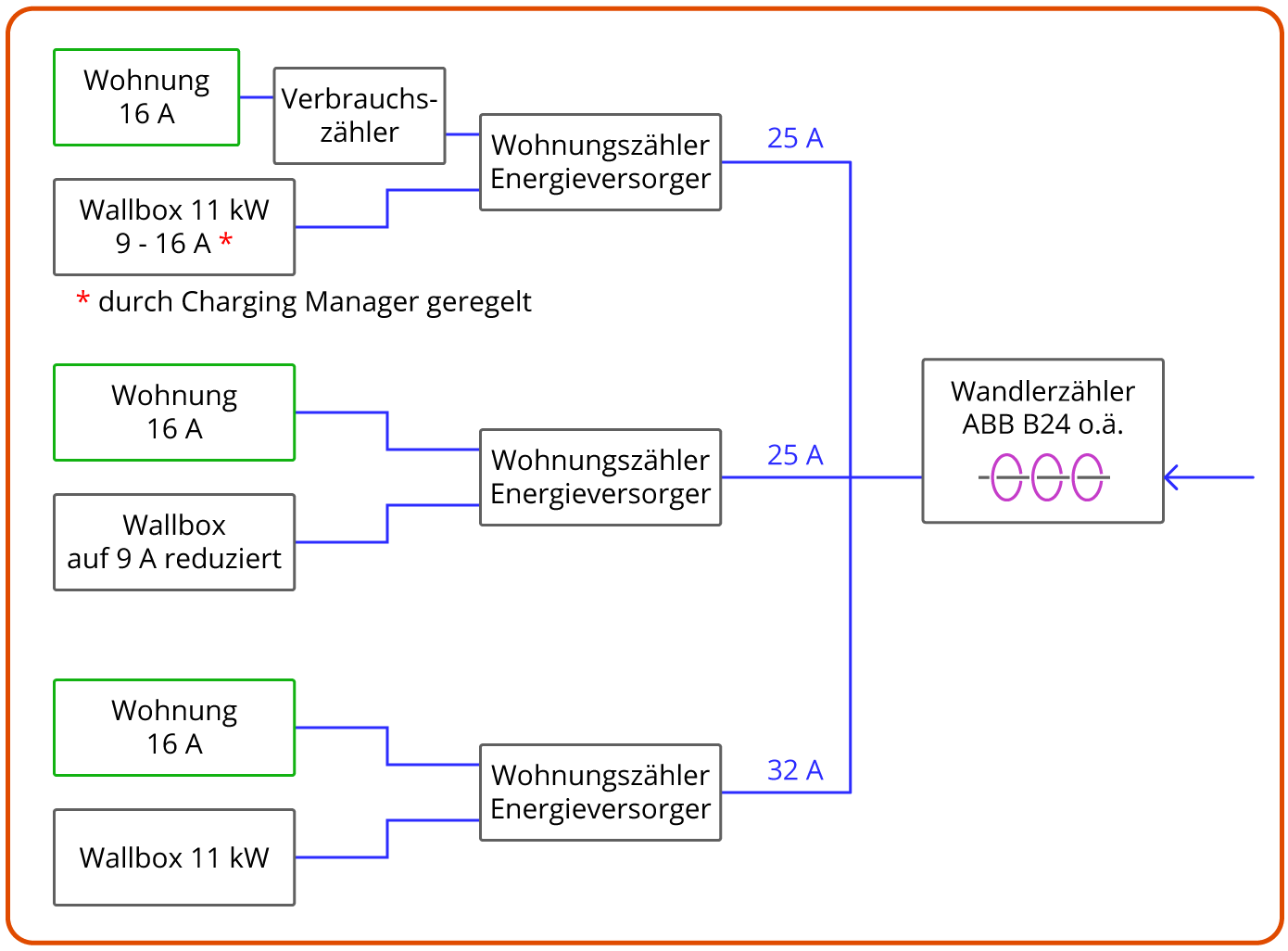Documentation
Parking garage for apartment building and condominiums
In very many cases, the flats and EVSEs can share the existing house connection power. There is no need to install an extra house connection to supply the EVSE. The load management system determines the consumption of the flats every 3 seconds and regulates the charging power so that the existing house connection value is not exceeded. The flats have higher priority, i.e. EVSEs are regulated down when the power demand of the flats increases.
Load profile for residential buildings: In the case of residential use, predominantly only a small part of the commissioned charging power is used. Peak loads typically occur between 4 and 7 p.m., when the residents come home and cook. During the rest of the time, the house connection power is almost entirely available to the EVSEs. Your grid operator can carry out a load measurement in your house to determine the actual power demand at all times of the day over a period of 1-2 weeks. In the example of an underground car park with 13 residential units, for example, the commissioned house connection power is 55kW, the base load during the day is approx. 1.5kW to 3.5kW and the peak load is approx. 20kW. So you have enough power to charge the e-cars.
Required energy and power: Statistically, a car drives about 40km per day. An electric car needs approx. 10kWh for this, so it is recharged in approx. 1 hour with an 11kW EVSE. Since users come at different times, only a few cars are charged at the same time. As of 02/2022, it is assumed that with 8 electric cars, an average of 1-2 cars will be charging at the same time. With 22kW EVSEs, simultaneous charging is even rarer. Three-phase charging cars can be regulated down to a minimum charging power of approx. 4.1kW. With an output of 42kW, it would therefore be possible to charge 10 cars at the same time without having to switch off individual EVSEs.
According to our experience, as a rule of thumb you can plan for approx. 3-4kW house connection power per parking space, i.e. for a garage with 20 EVSEs, approx. 60-80 kW house connection power should be sufficient for the garage and apartment building together. Further experience (and the experience of others) will probably show that even less than 3kW per parking space will be enough.
You should first determine how high the house connection capacity of your property is. A certain value was ordered from the grid operator / energy provider during construction. By the way: In most cases, the house connections can handle a little more power than was ordered. If you order more power, you will then have to pay the grid operator a flat-rate construction cost subsidy for reinforcing the distribution grid. It is best to take this opportunity to ask up to what value your capacity may be increased without requiring construction measures on your house connection. In the example above, 55kW are currently ordered, but technically 69kW would be possible (100A fuse). It's good if you still have a reserve available.
Form: Planning aid for the installation of a charging infrastructure
Download our planning aid for the installation of a charging infrastructure and fill out the form. The form first helps you to determine the basics in your building and compares three implementation variants. Normally, the costs for plan 1-3 do not differ much. Consult an electrician who can answer many technical questions. Then, in consultation with all parties, electricians and energy suppliers, you can decide how your charging infrastructure will be realised.
Note: To ensure that all calculations in the form are carried out automatically, you should open it in Adobe Acrobat Reader. In other PDF programmes, the formulas of the form fields may not be executed.
Proposal for the establishment of a charging infrastructure
An electrician or planner must check the specific existing installation. There may be requirements that are not (or cannot be) taken into account here. Set up a NH distributor with two outlets at the house connection: One for the flats and one for the parking garage. Integrate a (transformer) meter into the NH distributor input to record the power at the house connection (power of all flats and EVSEs). In the cFos Charging Manager, this meter has the role "grid reference" (here are some explanations about meters). The cFos Charging Manager needs this meter for the control. You can use the ABB B24 or Eastron SDM630 MCT as a meter, for example.

In consultation with the electrician and the grid operator, install a converter meter behind the HN distributor in the supply line to the parking garage so that you can centrally bill the energy provider for the charging current. The energy supplier will use this meter to bill you for the energy used by the EVSE.
Behind this meter, you install a distribution cabinet from which all the EVSEs in the garage are wired in a star configuration. In this distribution cabinet, there is a simple type A RCD for each EVSE (the expensive type B is only needed if the EVSE does not have its own DC residual current detection), a circuit breaker (fuse) and, if necessary, a calibrated (i.e. MID certified) meter. Here is an explanation of what you need to take into account when billing your electricity consumption. At the end of the year, you can simply read all these meters and charge the car park users as additional costs. The cFos Charging Manager helps you with a transaction log that records all charging processes. You can also install meters at the individual parking spaces or use EVSEs with built-in meters.
in the context of apartment buildings, we recommend the use of meters with phase-accurate recording of the charging current so that the cFos Charging Manager can calculate the charging currents per phase and then better utilise the available house connection power. You should always connect the EVSE with phase rotation in order to avoid peak currents on individual phases and also inform the cFos Charging Manager of this in the EVSE configuration under "Phase rotation".
Access to individual EVSEs can optionally be controlled with the cFos Charging Manager using RFID readers in the EVSEs or a central RFID reader.
Depending on local conditions, you can also install a rail system in the garage instead of star-shaped wiring, from which the individual EVSEs are branched off. You should compare the costs here. Under certain circumstances, there may be retrofitting obligations in the event of changes to the house connection. You must ask your planner or electrician about this. If, for example, the meter system has to be replaced at great expense, it may be more cost-effective to install a separate house connection for the garage.
If your parking garage is used by several houses, you can supply a part of the parking spaces from the house connections of each house according to the above rule of thumb. If, for example, two houses share a garage with 20 parking spaces, 10 parking spaces could be supplied from each house connection by means of a distribution cabinet. You then operate one load management per house connection.
Many details are described here in the example of an underground car park with 13 residential units. Here you will also find a schematic representation of the wiring and arrangement of the meters.
In homeowners' associations, the central infrastructure, i.e. NH distributor, travelling meter and distribution cabinet, is often installed and each party wishing to upgrade their parking space with a EVSE bears the cost of laying the cables from the distribution cabinet, the EVSE and a share of the central supply. In this way, the garage can be upgraded step by step as needed.
EVSEs behind the meters of the residential units
In some apartment buildings, it is desirable for the EVSEs to run via the meters in the flats. This saves the energy supplier's transformer meter in the house connection room, but requires that the flat meters and the lines leading from them are sufficiently dimensioned. For flats, you must calculate with a current of approx. 16A per phase (e.g. for dishwasher or washing machine). An 11kW EVSE draws up to 16A per phase.
As described above, you must install a central meter in the house that measures the power consumption at the house connection. Then the cFos Charging Manager can control all EVSEs so that the maximum house connection power is not overbooked.

If the power connections in the flats are strong enough to operate all household appliances and the EVSE, you do not need to configure anything else (e.g. with a connected load of 32A per phase and an 11kW EVSE). If the power connection is not strong enough, it may be sufficient to permanently limit the EVSE to 12A or 14A.
With the cFos Charging Manager, however, you can also configure the EVSEs so that they share the power with the respective flat. To do this, you need to install a consumption meter for the flat power. The cFos Charging Manager can then temporarily reduce the EVSE's power depending on the consumption of the other devices in the flat. However, you should always plan for a reserve of at least 6-7A, as an EVSE can only be regulated down to a minimum of 6A (approx. 4.1kW).
This constellation eliminates the need for the energy supplier's transformer meter and the separate billing of the EVSE electricity, as this is supplied via the flat meter. The disadvantage is that the entire house connection power is not potentially available to each EVSE, but each EVSE is additionally limited by the respective flat consumption.
